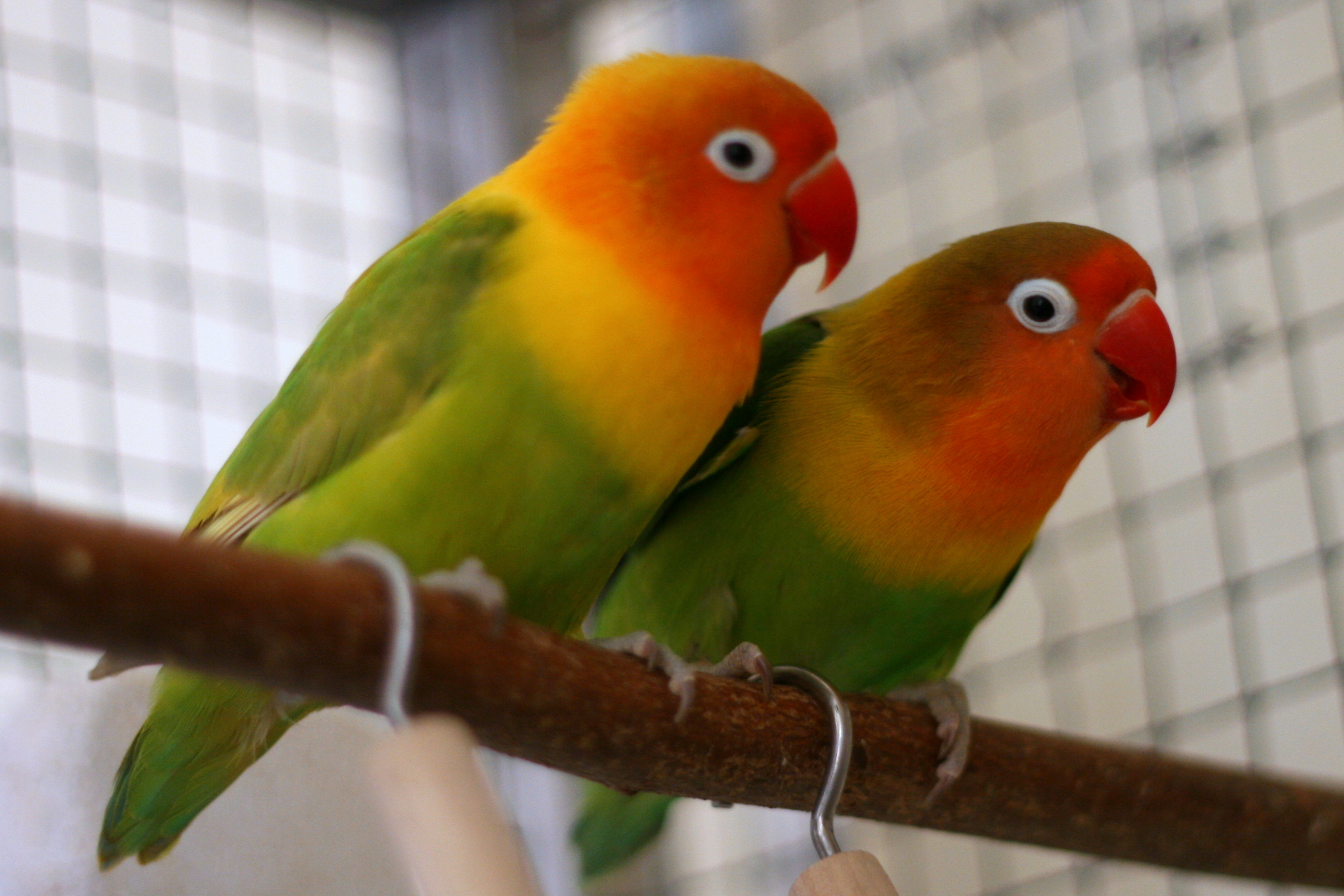
Fisher's lovebird (Agapornis fischeri)
Phylum —chordata
Class — aves
Order — psittaciformes
Family — psittaculidae
Genus – agapornis
Appearance
The Fischer's lovebird has a green back, chest, and wings. Their necks are a golden yellow and as it progresses upward it becomes darker orange. The top of the head is olive green, and the beak is bright red. The upper surface of the tail has some purple or blue feathers. It has a white circle of bare skin (eye-ring) around its eyes. Young birds are very similar to the adults, except for the fact that they are duller and the base of their mandible has brown markings. They are one of the smaller lovebirds, about 14 cm (5.5 in) in length and 43-58g weight.
Habitat
Fischer's lovebirds are native to a small area of east-central Africa, south and southeast of Lake Victoria in northern Tanzania.
Behavior
Fischer's lovebird has a fast flight, and the sound of their wings as they fly can be heard. Like all lovebirds, they are very vocal and when they do make noise they have a high-pitched chirp and can be very noisy.
Fischer's lovebirds tend to travel in tight flocks. Flock size varies from 10 to 20 individuals up to hundreds when they congregate at food sources.
Diet
Fischer's lovebirds eat a wide variety of foods, including seeds and fruit. They sometimes are pests to farmers, as they eat their crops such as maize and millet.
Reproduction
Fischer's lovebirds, like other lovebirds in the genus Agapornis, mate for life. The term lovebird arose from the strong bonds that mates make with one another. When separated, the physical health of each individual will suffer. Mates like to be in physical contact as much as possible.
The breeding season is January through April and June through July. The nest is in a hole in a tree 2 to 15 meters above the ground. The eggs are white and there are usually four or five in a clutch, but there could be as few as three or as many as eight. The female incubates the eggs for 23 days, and the chicks fledge from the nest about 38–42 days after hatching.
In captivity
Captive Fischer's lovebirds can live from 15 to 25 years.
Even if Fischer’s lovebirds look small, they’re exceptionally energetic, love to move about, and like to exercise and play like all other birds. And to do all of that, they require a cage that’s big enough. Small cages can cause further problems like self-mutilation, erratic behavior, attacking other birds (if there are any in the same cage), neurotic behavior, and so on. Not a good thing at all. Taking your birds out of their cage is also very, very helpful and somewhat compensates for a not-so-big cage.
Just make sure that your birds are not cooped up. The Fischer’s lovebird will develop certain problems very quickly and might also have a shortened lifespan as a result of that.
The lovebirds are very energetic. However, at the same time, they’re also very curious, bold, and inquisitive. It’s hard to imagine another small bird that’s very inquisitive as well as so energetic at the same time. Incidentally, you should have plenty of toys in their cage. Besides being social, they also need a lot of things to stay busy. A single Fischer’s lovebird will require many toys, ropes, etc. to break down and chew.
Also, these birds are always on the go. They don’t stop, rest for long periods of time, or become lethargic easily, like many other birds. The sedentary lifestyle is not for them and usually, they’ll do anything to stay active and fit. This makes sure obesity is out of the question.
Now, as they are called “love”-birds, you might think that they must be in pairs. Well, surely, if they are in a pair, they will be very fond of each other. A Fischer’s lovebird is known to create a deep bond with its partner. However, this can also mean that they spend the entirety of their time cuddling up to each other. If you’d love to see that – sure, go ahead and get a pair! However, if a Fischer’s lovebird is not in a pair, they will spend more time interacting with their owners. They require a great deal of social interaction and that’s why you’ll be able to have a very inquisitive but charming companion for yourself if you go with a single one.
Female Fischer’s lovebirds can be very territorially sensitive, making them very prone to defending their cage with quite the vigor.
As for the food, go for any pet bird food as they’re not very picky. Berries, cakes, fruits, vegetables, etc. are all very important but additional products are also required for mineral supplementation and taste. Keep the diet balanced and highly nutritive. Also, avoid a mostly seeds-based diet, which can lead to the deficiency of certain nutritional elements.
Look out for signs of chlamydiosis as a Fischer’s lovebird is going to be quite vulnerable to it.
 Russian
Russian
 English
English























